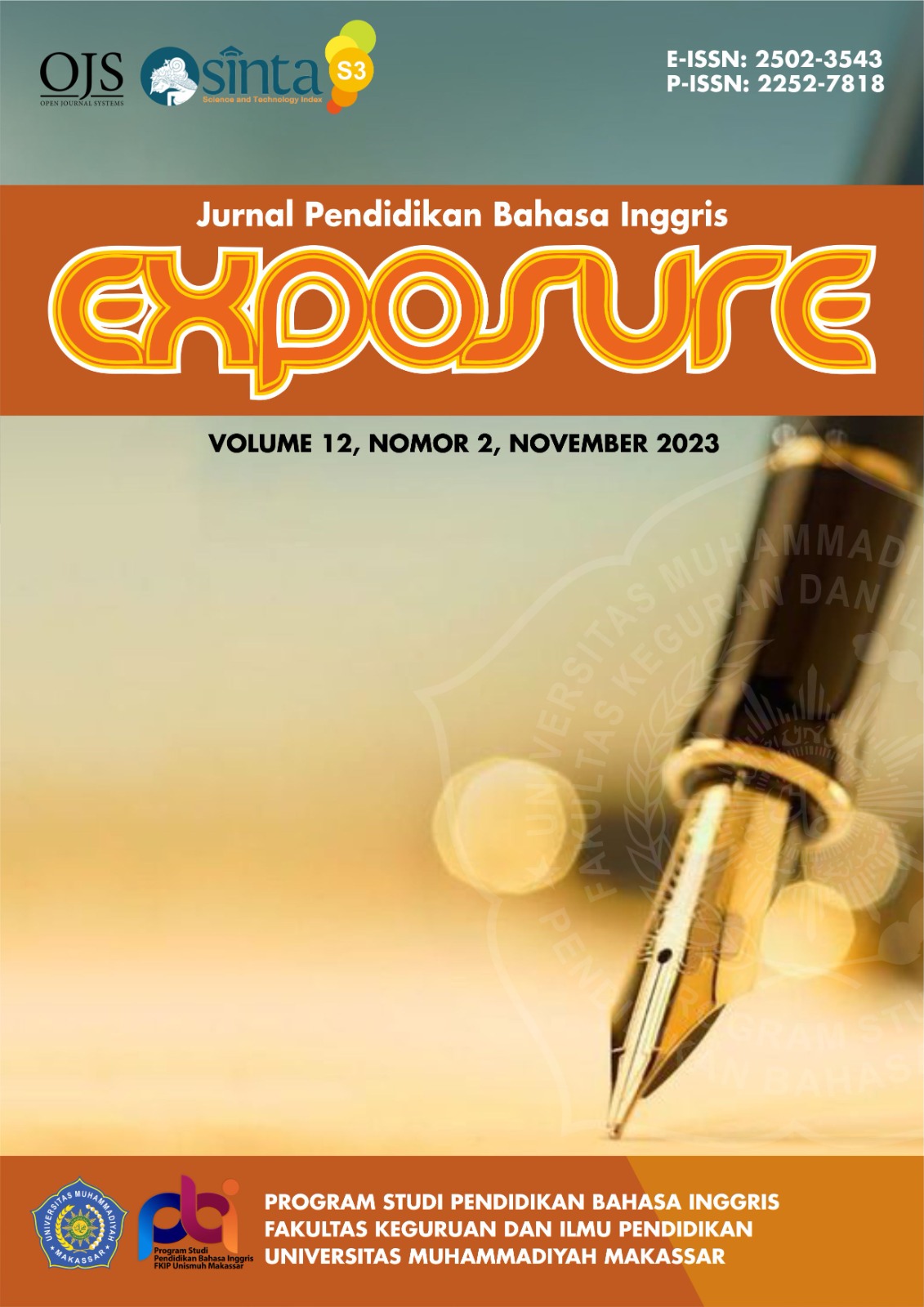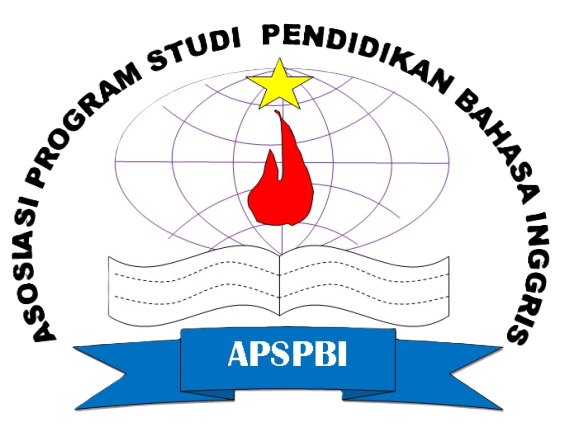IMPLEMENTATION OF MULTI-BLENDED LEARNING MODEL IN ENGLISH TEACHING AT THE REMOTE AREA SCHOOL IN BURU-MALUKU
DOI: https://doi.org/10.26618/exposure.v12i2.12635
Multi-Blended Learning Model, English Teaching, Remote Area
Abstract
Multi-blended learning model was combination of four learning models. They were independent learning model, face to face learning model, small group learning model, and online learning model. This research employed descriptive qualitative method. The research sample consisted of one teacher and 36 students at SMA Negeri 2 Buru, Maluku. The collected data employed observation and interview, and then the data is presented descriptively. The result study was used to explain the challenges faced by teacher and students’ perception in implementation of Multi-Blended Learning Model in English teaching at the remote area school. The challenges faced in independent learning model were low interest and motivation to learn independently, low control and sufficient attention from parents, low support from parents, and low economic level of students’ parents. The second challenges faced in face to face classroom learning model were limited teaching time, large number of students in one class, and different English ability in one class. Several obstacles found in small group learning model were limited teaching time, and large number of students in one class. The obstacles found in online learning model was that some students did not have internet data package, so they could not update information and new materials optimally. Students’ perception that multi-blended learning model was very helpful for students to collaborate and interact among students and teacher. Students became enthusiastic to learn independently and understanding of teacher’s material well through video tutorial available on the teacher’s YouTube content.
References
Annamalai N. (2019). Using WhatsApp to Extended Learning in a Blended Classroom Environment. Journal of Teaching English with Technology, 19(1), pp.3-20. http://www.tewtjournal.org
Ahmed S.T.S. (2019). Chat and Learn: Effectiveness of Using WhatsApp as a Pedagogical Tool to Enhance EFL Learners’ Reading and Writing Skills. International Journal of English Language and Literature Studies, 8(2), pp.61-68. doi:10.18488/journal.23.2019.82.61.68
A. Srinivasacharlu (2020). Using Youtube in Colleges of Education. International Journal of Education, 8(2), pp.21-24. doi:https://doi.org/10.34293/ education.v8i2.1736
Bin-Tahir S.Z, Mutmainnah, Mufidah N. (2016). Multi-Blended Learning Model for Remote Area Schools in Pandemic Covid-19 Situation. Journal of Teaching and Education for Scholars (JOTES), 1(1), pp.38-46.
Bin-Tahir S.Z., Tenriawali A.Y., Umanailo M.C.B., Iye R. (2021). Designing English Teaching Model at the Remote Area Schools of Maluku in Covid-19 Pandemic Situation. IEOM Society International: Proceedings of the 11th Annual International Conference on Industrial Engineering and Operations Management, pp.3933-3939.
Chandradasa S. & Jayawardena D. (2018). Peer Group Influence on Learning English as a Second Language; with Special Focus to the University of Ruhuna. Track of Humanities, Social Sciences & Law: Proceedings of the 4th Jaffna University International Research Conference (JUICe), pp.173-175.
Dabamona M., & Yunus A. (2021). The Use of Youtube for Learning English: Exploring Technology-Based Approach. Interference Journal of Language, Literature, and Linguistics, 1(10), pp.68-89. doi:10.26858/interference.v3i1.31475
Ferri F., Grifoni P. & Guzzo T. (2020). Online Learning and Emergency Remote Teaching: Opportunities and Challenges in Emergency Situations. Journal of Societies, pp.2-18. doi:10.3390/soc10040086
Hendriwanto, Desela R.D., & Sharda R.S. (2021). Exploring the University Students in Learning English from YouTubers. Academic journal Perspective: Language, Education, and Literature, 9(2), pp.116-123. doi: http://dx.doi.org/10.33603/perspective.v9i2.6089
Hentihu V.R., Badu T.K., Mukadar S., Loilatu S.H., & Lisaholit S. (2022). Optimizing the Role Of Driving Teachers in Independent Learning Education At SMP Negeri 2 Jikumerasa: Optimalisasi Peran Guru Penggerak dalam Pendidikan Merdeka Belajar di SMP Negeri 2 Jikumerasa. DUKASIA: Jurnal Pendidikan dan Pembelajaran, 3(3), pp. 409-416. ISSN: 2721-1150 EISSN: 2721-1169
Ikadar S., Bhattacharya S., & Tamarapalli V. (2018). A Blended Learning Platform to Improve Teaching-Learning Experience. International Conference on Advanced Learning Technologies (IEEE), pp.87-89. doi: 10.1109/ICALT.2018.00027
Listiani N.K.M, Suwastini N.K.A, Dantes G.R., Adnyani N.L.P.S., & Jayantin G.A.S.R. (2020). YouTube as Digital Learning Resources for Teaching Bilingual Young Learners. Journal of Atlantic Press. Advances in Social Science, Education and Humanities Research: Proceedings of the 2nd International Conference on Technology and Educational Science (ICTES), 2020(540), pp.156-162.
Loilatu S.H., Mukadar S., Badu T.K., Hentihu V.R., & Kasmawati (2022). Teacher Perception of Imlementing Independent Learning Through Blended-Learning Model at SMA Negeri 12 Buru: Persepsi Guru Terhadap Penerapan Merdeka Belajar Melalui Model Pembelajaran Blended Learning pada SMA Negeri 12 Buru. EDUKASIA: Jurnal Pendidikan dan Pembelajaran, 3(3), pp.377-386. ISSN: 2721-1150 EISSN: 2721-1169
Mazulfah, Faridi A., Rukmini D., & Mujiyanto J. (2021). Challenges of English Language Teaching in Post-Pandemic Era at Iain Salatiga. ELTLT Journal, pp.1-6, doi:10.4108/eai.14-8-2021.2317616
Prahmana R.C.I., Hartanto D., Kusumaningtyas D.A., Ali R.M., & Muchlas (2021). Community radio-based blended learning model: A promising learning model in remote area during pandemic era. Journal of Elseiver, 7(2021). pp.1-10. doi.org/10.1016/j.heliyon.2021.e07511
Sari R. & Karsen M. (2016). An Empirical Study on Blended Learning to Improve Quality of Learning in Higher Education. International Conference on Information Management and Technology (ICIMTech), pp.235-240.
Singh H. (2021). Building Effective Blended Learning Programs. IGI Global. pp.15-16. doi: 10.4018/978-1-7998-7607-6.ch002
Singh J., Steele K., & Singh L. (2021). Combining the Best of Online and Face-to-Face Learning: Hybrid and Blended Learning Approach for COVID-19, Post Vaccine, & Post Pandemic World. Journal of Educational Technology Systems, 50(2), pp.140-171. doi.10.1177/00472395211047865T
Solfema & Wahid S. (2018). Peer Group Learning Method to Improve the College Student’s Achievement. Journal of Nonfromal Education (JNE), 4(2), pp.187-196. doi: http://dx.doi.org/10.15294/jne.v4i2.16008
Tahmia T. (2023). Students’ Perception of the Use of YouTube in English Language Learning. Journal of Languages and Language Teaching (JOLLT), 11(1), pp.151-159. doi: https://doi.org/10.33394/jollt.v%vi%i.6883
Ujianti P.R. (2020). Challenges Faced by Teachers in Remote Area During Pandemic Covid-19. Atlantis Press SARL: Advances in Social Science, Education and Humanities Research. Proceedings of the 5th International Conference on Early Childhood Education (ICECE 2020), 538, pp.343-346.
Zayyed N.M. (2016). Special Designed Activities for Learning English Language through the Application of WhatsApp. Journal of English Language Teaching, 9(2), pp.199-204. doi.org/10.5539/elt.v9n2p199
Zheng X. & Guo J. (2019). Towards the Differences on Deep Learning of students in Blended Learning environmental. International Joint Conference on Information, Media and Engineering (IJCIME), pp.93-96. doi: 10.1109/IJCIME49369.2019.00028
Downloads
Published
How to Cite
Issue
Section
License
Authors who publish with this journal agree to the following terms:
In order to assure the highest standards for published articles, a peer review policy is applied. In pursue of the compliance with academic standards, all parties involved in the publishing process (the authors, the editors and the editorial board and the reviewers) agree to meet the responsibilities stated below in accordance to the Journal publication ethics and malpractice statement.
Duties of Authors:
- The author(s) warrant that the submitted article is an original work, which has not been previously published, and that they have obtained an agreement from any co-author(s) prior to the manuscript’s submission;
- The author(s) should not submit articles describing essentially the same research to more than one journal;
- The authors(s) make certain that the manuscript meets the terms of the Manuscript Submission Guideline regarding appropriate academic citation and that no copyright infringement occurs;
- The authors(s) should inform the editors about any conflict of interests and report any errors they subsequently, discover in their manuscript.
Duties of Editors and the Editorial Board:
- The editors, together with the editorial board, are responsible for deciding upon the publication or rejection of the submitted manuscripts based only on their originality, significance, and relevance to the domains of the journal;
- The editors evaluate the manuscripts compliance with academic criteria, the domains of the journal and the guidelines;
- The editors must at all times respect the confidentiality of any information pertaining to the submitted manuscripts;
- The editors assign the review of each manuscript to two reviewers chosen according to their domains of expertise. The editors must take into account any conflict of interest reported by the authors and the reviewers.
- The editors must ensure that the comments and recommendations of the reviewers are sent to the author(s) in due time and that the manuscripts are returned to the editors, who take the final decision to publish them or not.
Authors are permitted and encouraged to post online a pre-publication manuscript (but not the Publisher’s final formatted PDF version of the Work) in institutional repositories or on their Websites prior to and during the submission process, as it can lead to productive exchanges, as well as earlier and greater citation of published work (see The Effect of Open Access). Any such posting made before acceptance and publication of the Work shall be updated upon publication to include a reference to the Publisher-assigned DOI (Digital Object Identifier) and a link to the online abstract for the final published Work in the Journal.














